
Roach backs, dips, sway backs (like a horse) or “mushy soft” backs on a dog generally indicate that there’s something amiss with either the dog’s front or rear structure. It’s really important to know what is correct for your dog’s breed because a level top line isn’t necessarily correct for some breeds like the Bedlington Terrier whose standard actually calls for a good natural arch over the loin.
There’s an old expression said of a dog whose breed standard calls for a sound level top line that, “the dog could serve you cocktails on her back,” it’s so level and “quiet” as the dog gaits. Conversely, a “roach” top line is a rise in the back of any breed that is supposed to have a level top line. A cocktail on the back of the dog seen here would tip over and spill, and it usually indicates a problem with the dog’s rear structure.
Why?
It depends. Put very simplistically, sometimes a dog compensates, or “roaches” their spine to take weight off their rear end because the dog was born with bones, muscles and tendons of its rear quarters put together poorly.
Sometimes an old dog with arthritic changes in the back can appear to “roach,” but a roach back can also appear on a younger dog because of a steep croup, low withers, or a combination of any of these. Sometimes, a roached back points to slipped hocks because the dog builds muscle in the back to compensate for weight-bearing problems in the hind legs. It’s not only uncomfortable, it will eventually lead to a structural breakdown.
If you believe your dog has a roach back, what do you do?
You love him, spoil her rotten, and enjoy his or her company. Go for walks, have fun tossing a ball, and play. What you don’t do is participate in high performance events like agility, dock diving or disc competition because problems with the rear can exacerbate lower back problems.
Knowing about dog structures isn’t just for show dog people. It’s for all dog owners.

Is this a genetic defect?
Gail, structural faults can be a combination of things, but are often the result of breeding faults to faults, often out of a lack of awareness about structure.
This is a characteristic of the Bedlington Terrier and is in the breed standard.
Hi there I feel my 6 month old daschund has a roach back or IVDD. She displays no symptoms other than the arch. Just wondering your thoughts
She might, Leanda, but the real experts would be other Dachshund owners. Perhaps one reading this might weigh in?
Great information!